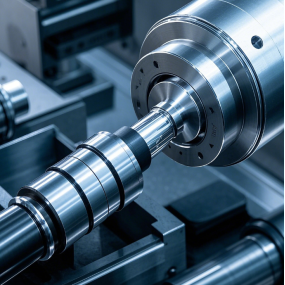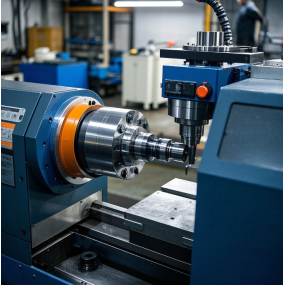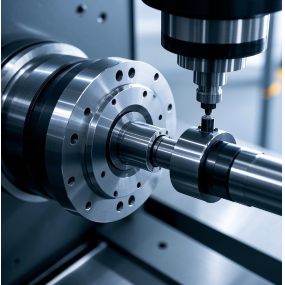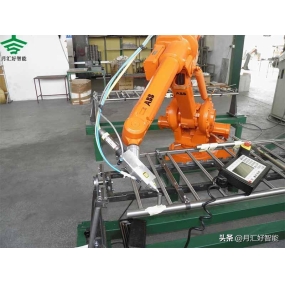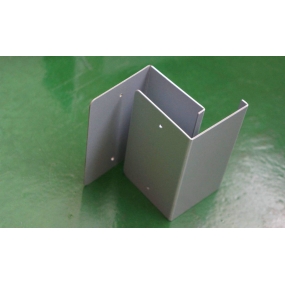1. CNC Machining workpiece is not cleaned and there are no anti-oxidation measures. During the machining process, parts inevitably come into contact with coolant stock solution, air and water. Affected by these factors, white oxide patches are produced on the surface of the workpiece. We use orthogonal test to analyze the influence of three factors of coolant stock solution, water and air on the generation of white oxide patches. The level is defined as yes and no, respectively.  The coolant stock solution and water droplets are placed on the surface of the workpiece, and the air is isolated by applying Vaseline. The test time is 13 days (the processing cycle of the part‘s external dimensions is about 13 days). The results show that the surface oxidation corrosion is generated under the action of coolant stock solution and air, resulting in the parts not meeting the surface treatment requirements. Therefore, the workpiece is not cleaned and no anti-oxidation measures are one of the reasons for the low qualified rate of parts manufacturing. 2. Lack of tooling equipment In order to verify the inference of the team, we trial-manufactured and processed 3 other products with special polishing equipment during the test process, and counted the scrap rate respectively. After comparing the scrap rate of the test product with the scrap rate of this part, it was found that the scrap rate was nearly 8 times different. Therefore, the lack of polishing equipment is another reason for the high scrap rate of the product. The traditional polishing method is to install the workpiece on the rotating equipment and press the outer circle of the part with sandpaper to polish. The traditional polishing method has the advantages of simple operation and good economy. It is widely used in the machining industry. Its shortcomings are obvious, such as: the polishing force is not constant, the feed is not continuous, and the polishing efficiency of the parts is low. We look for tooling design ideas from the traditional polishing method and retain the advantages. The polishing points are extracted, including: polishing contact surface (hand-held sandpaper), polishing force (arm press generated), feed amount (palm movement). A set of general polishing tooling is successfully designed by using the mechanical structure to achieve the above points. After using this tooling, the parts can achieve uniform force during polishing. This tooling can be installed on the polishing equipment tool holder, and the original function of the equipment can be combined to achieve uniform feed. At the same time, in order to avoid the polishing equipment grinding parts, polytetrafluoroethylene material with softer material, stronger toughness and high temperature resistance was selected as the material of the polishing head. For polishing sandpaper, we chose a certain type of polishing sandpaper with softer texture and adhesive backing. The actual use improves the machining pass rate of the parts through the optimization of the polishing method of the parts. The design of the general polishing tooling is a major highlight of this project. This tooling effectively solves the problems of unconstant polishing force, discontinuous feed and low polishing efficiency in the traditional polishing method. It provides a basis and reference experience for the processing of other precision shaft parts in the future.
The coolant stock solution and water droplets are placed on the surface of the workpiece, and the air is isolated by applying Vaseline. The test time is 13 days (the processing cycle of the part‘s external dimensions is about 13 days). The results show that the surface oxidation corrosion is generated under the action of coolant stock solution and air, resulting in the parts not meeting the surface treatment requirements. Therefore, the workpiece is not cleaned and no anti-oxidation measures are one of the reasons for the low qualified rate of parts manufacturing. 2. Lack of tooling equipment In order to verify the inference of the team, we trial-manufactured and processed 3 other products with special polishing equipment during the test process, and counted the scrap rate respectively. After comparing the scrap rate of the test product with the scrap rate of this part, it was found that the scrap rate was nearly 8 times different. Therefore, the lack of polishing equipment is another reason for the high scrap rate of the product. The traditional polishing method is to install the workpiece on the rotating equipment and press the outer circle of the part with sandpaper to polish. The traditional polishing method has the advantages of simple operation and good economy. It is widely used in the machining industry. Its shortcomings are obvious, such as: the polishing force is not constant, the feed is not continuous, and the polishing efficiency of the parts is low. We look for tooling design ideas from the traditional polishing method and retain the advantages. The polishing points are extracted, including: polishing contact surface (hand-held sandpaper), polishing force (arm press generated), feed amount (palm movement). A set of general polishing tooling is successfully designed by using the mechanical structure to achieve the above points. After using this tooling, the parts can achieve uniform force during polishing. This tooling can be installed on the polishing equipment tool holder, and the original function of the equipment can be combined to achieve uniform feed. At the same time, in order to avoid the polishing equipment grinding parts, polytetrafluoroethylene material with softer material, stronger toughness and high temperature resistance was selected as the material of the polishing head. For polishing sandpaper, we chose a certain type of polishing sandpaper with softer texture and adhesive backing. The actual use improves the machining pass rate of the parts through the optimization of the polishing method of the parts. The design of the general polishing tooling is a major highlight of this project. This tooling effectively solves the problems of unconstant polishing force, discontinuous feed and low polishing efficiency in the traditional polishing method. It provides a basis and reference experience for the processing of other precision shaft parts in the future.
Hello! Welcome to EMAR's website!
 English
English » »
» »
 Spanish
Spanish Arabic
Arabic Spanish Basque
Spanish Basque Portuguese
Portuguese Belarusian
Belarusian Japanese
Japanese Russian
Russian Icelandic
Icelandic Bulgarian
Bulgarian Azerbaijani
Azerbaijani Estonian
Estonian Irish
Irish Polish
Polish Persian
Persian Boolean
Boolean Danish
Danish German
German French
French Filipino
Filipino Finnish
Finnish Korean
Korean Dutch
Dutch Galician
Galician Catalan
Catalan Czech
Czech Croatian
Croatian Latin
Latin Latvian
Latvian Romanian
Romanian Maltese
Maltese Malay
Malay Macedonian
Macedonian Norwegian
Norwegian Swedish
Swedish Serbian
Serbian Slovak
Slovak Slovenian
Slovenian Swahili
Swahili Thai
Thai Turkish
Turkish Welsh
Welsh Urdu
Urdu Ukrainian
Ukrainian Greek
Greek Hungarian
Hungarian Italian
Italian Yiddish
Yiddish Indonesian
Indonesian Vietnamese
Vietnamese 简体中文
简体中文 Haitian Creole
Haitian Creole


